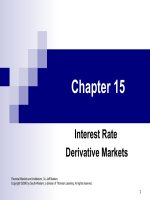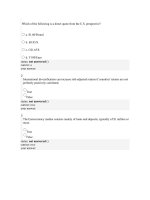chuong 6 7 e quiz Thị trường tài chính và các định chế tài chính Madura
Bạn đang xem bản rút gọn của tài liệu. Xem và tải ngay bản đầy đủ của tài liệu tại đây (80.86 KB, 8 trang )
Chương 6 – 7e
Which of the following are cost-related motives for direct foreign investment?
a. entering profitable markets
b. using foreign technology and raw materials
c. reacting to trade restrictions
d. All of the answers are correct.
correct: b
2
Firms should always locate production where the cost of labor is cheapest.
True
False
correct: false
3
Examples of techniques MNCs use for foreign direct investment are joint ventures, acquisitions, and the
establishment of new subsidiaries.
True
False
correct: true
4
Many governments have a tradition of limited foreign majority ownership.
True
False
correct: true
5
Firms often use direct foreign investment as a defensive strategy to circumvent barriers to trade.
True
False
correct: true
6
What are some drawbacks to direct foreign investment?
a. A substantial investment is usually required.
b.
If the investment does not perform as well as anticipated, it can be difficult to sell the foreign
project.
c. The large amounts of capital invested can be put at risk if the government takes adverse actions.
d. All of the answers are correct.
correct: d
7
Assume labor costs are lower in Country X than Country Y. Which factors might encourage a U.S. firm
to locate production in Country Y?
a. Higher risk of terrorism and threats to workers in Country X.
b. More restrictive government policies in Country Y.
c.
A higher correlation of returns between Country Y and the U.S. than between Country X and the
U.S.
d. All of the answers are correct.
correct: a
8
Which of the following are reasons that a firm may want to attract new sources of demand through DFI?
a. Growth or potential for market share enhancement may be limited in the home country.
b. The local product market may not be competitive due to restrictions on imports in the past.
c. Disposable income is rising in many transition and developing countries.
d. All of the answers are correct.
correct: d
9
Firms should take into account the correlation of returns between investments when making DFI
decisions.
True
False
status: not answered ()
correct: true
your answer:
10
Which of the following is true regarding joint ventures?
a. Joint ventures are not a form of DFI.
b. Joint ventures involve collaboration between two or more firms.
c. Joint ventures typically involve less of an initial investment than an acquisition.
d. None of the answers are correct.
status: not answered ()
correct: b
your answer:
11
The Single European Act encouraged U.S. MNCs to consolidate their European plants and recognize
gains from economies of scale.
True
False
status: not answered ()
correct: true
your answer:
12
Acquisitions are the best way to obtain or learn about a key strategic technology available in a foreign
market.
True
False
status: not answered ()
correct: false
your answer:
13
Which of the following is correct regarding the decision to remit funds to parents or to use funds for
the subsidiary?
a.
If the parent's return on the funds exceeds the subsidiary's return on the funds, the parent should
always allow the subsidiary to retain funds.
b.
If the subsidiary's return on the funds exceeds the parent's return on the funds, the subsidiary
should always retain the funds.
c.
The remittance decisions should be made on a case-by-case basis, depending on economic
conditions in both countries as well as restrictions imposed by host country governments.
d. None of the answers are correct.
status: not answered ()
correct: c
your answer:
14
Governments typically prefer DFI that generates a great deal of competition for local firms.
True
False
status: not answered ()
correct: false
your answer:
15
Government restrictions on foreign direct investment are most often driven by:
a. the desire to keep unemployment down.
b. the desire to limit negative impacts on local firms.
c. the desire to limit capital outflow.
d. All of the answers are correct.
status: not answered ()
correct: d
your answer:
16
Financial market considerations, such as interest rate differentials, should be considered along with
product market aspects when making a DFI decision.
True
False
status: not answered ()
correct: true
your answer:
17
Direct foreign investment, through the effects of diversification, pushes out the efficient frontier for
multiproduct MNCs.
True
False
status: not answered ()
correct: true
your answer:
18
An example of a red-tape barrier to direct foreign investment is bureaucracy.
True
False
status: not answered ()
correct: true
your answer:
19
Direct foreign investment refers to:
a. investment in real assets in a foreign country.
b. investment in a portfolio of stocks on their own exchange.
c. buying stock and bonds through a broker in the home country.
d. None of the answers are correct.
status: not answered ()
correct: a
your answer:
20
Which of the following strategies is appropriate for an MNC attempting to obtain or develop a new
strategic technology?
a. acquisition of a foreign firm
b. joint venture
c. establishment of a foreign subsidiary
d. None of the answers are correct.
status: not answered ()
correct: b
your answer:
21
According to the text, the region that receives the largest amount of DFI from U.S. firms is:
a. Canada.
b. Latin America.
c. Europe.
d. None of the answers are correct.
status: not answered ()
correct: c
your answer:
22
Which of the following DFI strategies is most appropriate for fully benefiting from economies of
scale?
a. joint venture
b. acquisition of unrelated businesses
c. establishment of a subsidiary in a new market that can sell products produced elsewhere
d. None of the answers are correct.
status: not answered ()
correct: c
your answer:
23
Which of the following is a revenue-related motive for direct foreign investment?
a. benefiting from economies of scale
b. using foreign factors of production
c. exploiting monopolistic advantages
d. All of the answers are correct.
status: not answered ()
correct: c
your answer:
24
Which of the following are true regarding international diversification?
a.
When global crises occur, MNCs may not be completely insulated, but those that are diversified
among several countries will likely face less of an impact than those that have concentrated
operations.
b.
Firms should invest in projects where the returns are highly positively correlated with each other
and with the projects of the firm in the home country.
c.
An internationally diversified MNC should expect that the variation of returns will increase as a
result of locating production overseas.
d. All of the answers are correct.
status: not answered ()
correct: a
your answer:
25
Exploiting monopolistic advantages is an example of a cost-related motive for DFI.
True
False
status: not answered ()
correct: false
your answer:
26
If a firm seeks to fully benefit from economies of scale, they should establish a subsidiary in a new
market that can sell products produced elsewhere.
True
False
status: not answered ()
correct: true
your answer:
27
Firms considering DFI in an effort to exploit monopolistic advantages should establish subsidiaries in
markets where competitors cannot produce the same product, and then sell products in that country.
True
False
status: not answered ()
correct: true
your answer:
28
Which of the following is not an example of government incentives to encourage direct foreign
investment?
a. Limitations on restructuring so that layoffs and higher unemployment do not occur.
b. The sale of government land to the foreign firm at a discount.
c. Providing low corporate tax rates on specific businesses.
d. None of these are examples of government incentives.
status: not answered ()
correct: a
your answer:
29
Which of the following statements are false?
a. Firms should attempt to make direct foreign investments that plot on the efficient frontier.
b.
Firms should always engage in direct foreign investment in countries where the cost of labor is
lowest.
c.
Firms can reduce their overall risk by making direct foreign investments that have a low
correlation of returns with home country returns.
d. All of the answers are correct.
status: not answered ()
correct: b
your answer:
30
During global crises, MNCs with direct foreign investment are completely isolated from adverse price
movements because they are diversified.
True
False
status: not answered ()
correct: false









